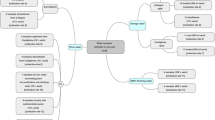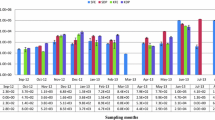Abstract
In order to provide a more suitable response to public health concerns, we improved the detection of infectious human adenoviruses in water by optimising the commonly used integrated cell culture–PCR method. Risk evaluation studies seek for rapid detection of infectious adenoviruses, including the enteric types 40 and 41 that are considered as the second most common agents of gastroenteritis in children next to rotaviruses. The here-employed 293A cell line used for infectious status assessment showed its ability to multiply adenoviruses including type 41. Two modifications were moreover applied to the workflow for viral detection. The first occurred at the nucleic acid extraction step performed directly on all infected cells, while the second was the application of real-time quantitative PCR as detection tool. All adaptations led to a 3-day reduction of the response delay and an improved sensitivity especially for the enteric adenoviral types. The infectious status of laboratory strain types 2 and 41 was demonstrated by a more than 2-log10 increase in genome quantity. These conclusions were confirmed and reinforced by the analysis of water samples applying the improved assay. Naturally occurring infectious adenoviruses were detected in wastewater and river water, within 2 days. Types belonging to the species human adenoviruses C and type 31 were observed, but the most frequently identified type was 41 (71 % of identified sequences, n = 34). This highlights the usefulness of our method for a wide range of types, and especially for the most prevalent and public health-relevant enteric adenoviruses.

Similar content being viewed by others
References
Allard A, Albinsson B, Wadell G (2001) Rapid typing of human adenoviruses by a general PCR combined with restriction endonuclease analysis. J Clin Microbiol 39:498–505
Bofill-Mas S, Albinana-Gimenez N, Clemente-Casares P, Hundesa A, Rodriguez-Manzano J, Allard A, Calvo M, Girones R (2006) Quantification and stability of human adenoviruses and polyomavirus JCPyV in wastewater matrices. Appl Environ Microbiol 72:7894–7896
Bofill-Mas S, Calgua B, Clemente-Casares P, La Rosa G, Iaconelli M, Muscillo M, Rutjes SA, de Roda Husman AM, Grunert A, Graber I, Verani M, Carducci A, Calvo M, Wyn-Jones P, Girones R (2010) Quantification of human adenoviruses in European recreational waters. Food Environ Virol 2:101–109
Dey SH, Hoq I, Okitsu S, Hayakawa S, Ushijima H (2013) Prevalence, seasonality, and peak age of infection of enteric adenoviruses in Japan, 1995–2009. Epidemiol Infect 141:958–960
Dong Y, Kim J, Lewis GD (2010) Evaluation of methodology for detection of human adenoviruses in wastewater, drinking water, stream water and recreational waters. J Appl Microbiol 108:800–809
Gerrity D, Ryu H, Crittenden J, Abbaszadegan M (2008) UV inactivation of adenovirus type 4 measured by integrated cell culture qPCR. J Environ Sci Health A Toxic Hazard Subst Environ Eng 43:1628–1638
Graham FL, Smiley J, Russell WC, Nairn R (1977) Characteristics of a human cell line transformed by DNA from human adenovirus type 5. J Gen Virol 36:59–72
Greening GE, Hewitt J, Lewis GD (2002) Evaluation of integrated cell culture-PCR (C-PCR) for virological analysis of environmental samples. J Appl Microbiol 93:745–750
Grimm AC, Cashdollar JL, Williams FP, Fout GS (2004) Development of an astrovirus RT-PCR detection assay for use with conventional, real-time, and integrated cell culture/RT-PCR. Can J Microbiol 50:269–278
Hamza IA, Jurzik L, Überla K, Wilhelm M (2011) Methods to detect infectious human enteric viruses in environmental water samples. Int J Hyg Environ Health 214:424–436
Hernroth BE, Conden-Hansson AC, Rehnstam-Holm AS, Girones R, Allard AK (2002) Environmental factors influencing human viral pathogens and their potential indicator organisms in the blue mussel, Mytilus edulis: the first Scandinavian report. Appl Environ Microbiol 68:4523–4533
Jiang SC (2006) Human adenoviruses in water: occurrence and health implications: a critical review. Environ Sci Technol 40:7132–7140
Jiang SC, Han J, He JW, Chu W (2009) Evaluation of four cell lines for assay of infectious adenoviruses in water samples. J Water Health 7:650–656
Ko G, Cromeans TL, Sobsey MD (2003) Detection of infectious adenovirus in cell culture by mRNA reverse transcription-PCR. Appl Environ Microbiol 69:7377–7384
Ko G, Jothikumar N, Hill VR, Sobsey MD (2005) Rapid detection of infectious adenoviruses by mRNA real-time RT-PCR. J Virol Methods 127:148–153
Lambertini E, Spencer SK, Bertz PD, Loge FJ, Borchardt MA (2010) New mathematical approaches to quantify human infectious viruses from environmental media using integrated cell culture-qPCR. J Virol Methods 163:244–252
Lee C, Lee SH, Han E, Kim SJ (2004) Use of cell culture-PCR assay based on combination of A549 and BGMK cell lines and molecular identification as a tool to monitor infectious adenoviruses and enteroviruses in river water. Appl Environ Microbiol 70:6695–6705
Lee SH, Lee C, Lee KW, Cho HB, Kim SJ (2005) The simultaneous detection of both enteroviruses and adenoviruses in environmental water samples including tap water with an integrated cell culture-multiplex-nested PCR procedure. J Appl Microbiol 98:1020–1029
Li D, He M, Jiang SC (2010a) Detection of infectious adenoviruses in environmental waters by fluorescence-activated cell sorting assay. Appl Environ Microbiol 76:1442–1448
Li D, Gu AZ, Yang W, He M, Xh H, Shi HC (2010b) An integrated cell culture and reverse transcription quantitative PCR assay for detection of infectious rotaviruses in environmental waters. J Microbiol Methods 82:59–63
Li F, Li F, Liu Y, Zhen X, Chen L (2009) An integrated cell culture and quantitative polymerase chain reaction technique for determining titers of functional and infectious adenoviruses. Anal Biochem 391:157–159
Mahalanabis M, Reynolds K, Pepper I, Gerba C (2010) Comparison of multiple passage integrated cell culture-PCR and cytopathogenic effects in cell culture for the assessment of poliovirus survival in water. Food Environ Virol 2:225–230
Maunula L, Klemola P, Kauppinen A, Söderberg K, Nguyen T, Pitkänen T, Kaijalainen S, Simonen M, Miettinen I, Lappalainen M, Laine J, Vuento R, Kuusi M, Roivainen M (2009) Enteric viruses in a large waterborne outbreak of acute gastroenteritis in Finland. Food Environ Virol 1:31–36
Mena KD, Gerba CP (2009) Waterborne adenovirus. Rev Environ Contam Toxicol 198:133–167
Reynolds KA, Gerba CP, Abbaszadegan M, Pepper IL (2001) ICC/PCR detection of enteroviruses and hepatitis A virus in environmental samples. Can J Microbiol 47:153–157
Reynolds KA, Gerba CP, Pepper IL (1996) Detection of infectious enteroviruses by an integrated cell culture-PCR procedure. Appl Environ Microbiol 62:1424–1427
Rigotto C, Victoria M, Moresco V, Kolesnikova CK, Corrêa AA, Souza DSM, Miagostovich MP, Simões CMO, Barardi CRM (2010) Assessment of adenovirus, hepatitis A virus and rotavirus presence in environmental samples in Florianopolis, South Brazil. J Appl Microbiol 109:1979–1987
Sinclair RG, Jones EL, Gerba CP (2009) Viruses in recreational water-borne disease outbreaks: a review. J Appl Microbiol 107:1769–1780
Siqueira-Silva J, Yeda FP, Favier AL, Mezin P, Silva ML, Barrella KM, Mehnert DU, Fender P, Harsi CM (2009) Infection kinetics of human adenovirus serotype 41 in HEK 293 cells. Mem Inst Oswaldo Cruz 104:736–744
Skraber S, Langlet J, Kremer JR, Mossong J, De Landtsheer S, Even J, Muller CP, Hoffmann L, Cauchie HM (2011) Concentration and diversity of noroviruses detected in Luxembourg wastewaters in 2008–2009. Appl Environ Microbiol 77:5566–5568
Wyn-Jones AP, Carducci A, Cook N, D'Agostino M, Divizia M, Fleischer J, Gantzer C, Gawler A, Girones R, Höller C, de Roda Husman AM, Kay D, Kozyra I, López-Pila J, Muscillo M, José Nascimento MS, Papageorgiou G, Rutjes S, Sellwood J, Szewzyk R, Wyer M (2011) Surveillance of adenoviruses and noroviruses in European recreational waters. Water Res 45:1025–1038
Xagoraraki I, Kuo DHW, Wong K, Wong M, Rose JB (2007) Occurrence of human adenoviruses at two recreational beaches of the great lakes. Appl Environ Microbiol 73:7874–7881
Acknowledgements
The present work was carried out in the framework of the PATHOS project (contract number C08/SR/08), supported by the National Research Fund, Luxembourg. This work was also supported by the LorLux network (French name, RésEAU LorLux) and the Moselle Workshop Zone (French abbreviation, ZAM). The authors would like to thank Cécile Walczak for her precious and excellent technical assistance, and also Dr L. Hoffmann for final reading of the manuscript. The LCPME also wishes to thank the Institut Carnot Énergie et Environnement en Lorraine (ICÉEL) for financial support (1.9 Action 009-OTELo).
Author information
Authors and Affiliations
Corresponding author
Rights and permissions
About this article
Cite this article
Ogorzaly, L., Cauchie, HM., Penny, C. et al. Two-day detection of infectious enteric and non-enteric adenoviruses by improved ICC-qPCR. Appl Microbiol Biotechnol 97, 4159–4166 (2013). https://doi.org/10.1007/s00253-013-4782-4
Received:
Revised:
Accepted:
Published:
Issue Date:
DOI: https://doi.org/10.1007/s00253-013-4782-4




